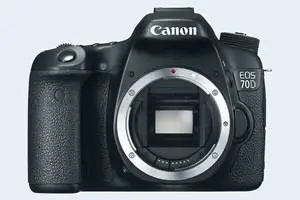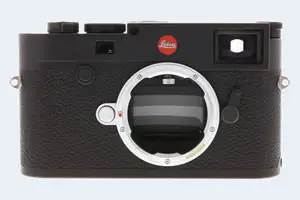Canon 70D vs Leica M10
The Canon EOS 70D and the Leica M10 (Typ 3656) are two enthusiast cameras that were revealed to the public, respectively, in July 2013 and January 2017. The 70D is a DSLR, while the M10 is a rangefinder-focusing mirrorless camera. The cameras are based on an APS-C (70D) and a full frame (M10) sensor. The Canon has a resolution of 20 megapixels, whereas the Leica provides 23.8 MP.
Below is an overview of the main specs of the two cameras as a starting point for the comparison.

Check 70D offers at
ebay.com

Check M10 offers at
ebay.com
Going beyond this snapshot of core features and characteristics, what are the differences between the Canon EOS 70D and the Leica M10 (Typ 3656)? Which one should you buy? Read on to find out how these two cameras compare with respect to their body size, their imaging sensors, their shooting features, their input-output connections, and their reception by expert reviewers.
Body comparison
The physical size and weight of the Canon 70D and the Leica M10 are illustrated in the side-by-side display below. The two cameras are presented according to their relative size. Three consecutive perspectives from the front, the top, and the back are available. All size dimensions are rounded to the nearest millimeter.
The M10 can be obtained in two different colors (black, silver), while the 70D is only available in black.
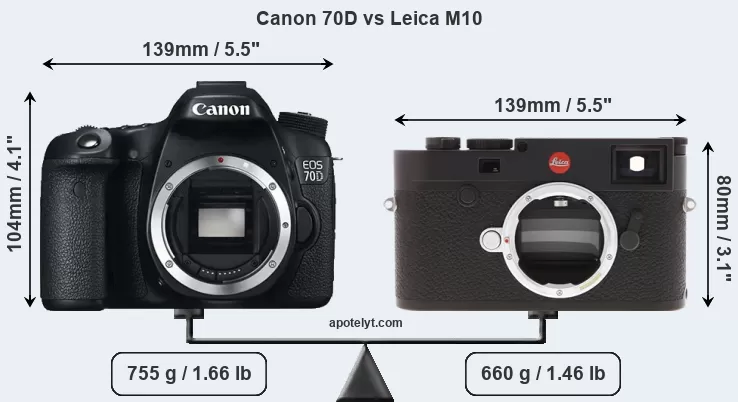

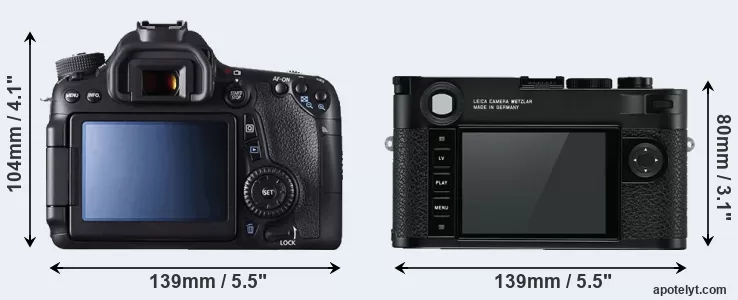
If the front view area (width x height) of the cameras is taken as an aggregate measure of their size, the Leica M10 is notably smaller (23 percent) than the Canon 70D. Moreover, the M10 is markedly lighter (13 percent) than the 70D. In this context, it is worth noting that both cameras are splash and dust-proof and can, hence, be used in inclement weather conditions or harsh environments.
The above size and weight comparisons are to some extent incomplete since they do not consider the interchangeable lenses that both of these cameras require. A larger imaging sensor will tend to go along with bigger and heavier lenses, although exceptions exist. You can compare the optics available for the two cameras in the Canon EF Lens Catalog (70D) and the Leica M Lens Catalog (M10).
Concerning battery life, the 70D gets 920 shots out of its Canon LP-E6 battery, while the M10 can take 210 images on a single charge of its Leica BP-SCL5 power pack.
The following table provides a synthesis of the main physical specifications of the two cameras and other similar ones. In case you want to display and compare another camera duo, you can use the CAM-parator app to select your camera combination among a large number of options.

| Camera Model |
Camera Width |
Camera Height |
Camera Depth |
Camera Weight |
Battery Life |
Weather Sealing |
Camera Launch |
Launch Price (USD) |
Street Price |
||
|---|---|---|---|---|---|---|---|---|---|---|---|
| 1. | Canon 70D | 139 mm | 104 mm | 79 mm | 755 g | 920 | Y | Jul 2013 | 1,199 | ebay.com | |
| 2. | Leica M10 | 139 mm | 80 mm | 39 mm | 660 g | 210 | Y | Jan 2017 | 6,595 | ebay.com | |
| 3. | Canon 6D | 145 mm | 111 mm | 71 mm | 770 g | 1090 | Y | Sep 2012 | 2,099 | ebay.com | |
| 4. | Canon 7D | 148 mm | 111 mm | 74 mm | 860 g | 800 | Y | Sep 2009 | 1,699 | ebay.com | |
| 5. | Canon 7D II | 149 mm | 112 mm | 78 mm | 910 g | 670 | Y | Sep 2014 | 1,799 | ebay.com | |
| 6. | Canon 50D | 146 mm | 108 mm | 74 mm | 822 g | 800 | Y | Aug 2008 | 1,299 | ebay.com | |
| 7. | Canon 60D | 145 mm | 106 mm | 79 mm | 755 g | 1100 | Y | Aug 2010 | 1,399 | ebay.com | |
| 8. | Canon 80D | 139 mm | 105 mm | 79 mm | 730 g | 960 | Y | Feb 2016 | 1,199 | ebay.com | |
| 9. | Canon G3 X | 123 mm | 77 mm | 105 mm | 733 g | 300 | Y | Jun 2015 | 999 | ebay.com | |
| 10. | Canon T5 | 130 mm | 100 mm | 78 mm | 480 g | 500 | n | Feb 2014 | 449 | ebay.com | |
| 11. | Leica M Typ 240 | 139 mm | 80 mm | 42 mm | 680 g | 500 | Y | Sep 2012 | 6,950 | ebay.com | |
| 12. | Leica M-E Typ 240 | 139 mm | 80 mm | 42 mm | 680 g | 500 | Y | Jun 2019 | 3,999 | ebay.com | |
| 13. | Leica M Typ 262 | 139 mm | 80 mm | 42 mm | 680 g | 400 | Y | Nov 2015 | 5,195 | ebay.com | |
| 14. | Leica M10-P | 139 mm | 80 mm | 39 mm | 660 g | 210 | Y | Aug 2018 | 7,995 | ebay.com | |
| 15. | Leica M11 | 139 mm | 80 mm | 39 mm | 640 g | 700 | Y | Jan 2022 | 8,995 | amazon.com | |
| 16. | Nikon D7100 | 136 mm | 107 mm | 76 mm | 765 g | 950 | Y | Feb 2013 | 1,199 | ebay.com | |
| 17. | Sony RX10 | 129 mm | 88 mm | 102 mm | 813 g | 420 | Y | Oct 2013 | 1,299 | ebay.com | |
| Note: Measurements and pricing do not include easily detachable parts, such as add-on or interchangeable lenses or optional viewfinders. | |||||||||||
Any camera decision will obviously take relative prices into account. The retail prices at the time of the camera’s release place the model in the market relative to other models in the producer’s line-up and the competition. The 70D was launched at a markedly lower price (by 82 percent) than the M10, which puts it into a different market segment. Normally, street prices remain initially close to the MSRP, but after a couple of months, the first discounts appear. Later in the product cycle and, in particular, when the replacement model is about to appear, further discounting and stock clearance sales often push the camera price considerably down. Then, after the new model is out, very good deals can frequently be found on the pre-owned market.
Sensor comparison
The imaging sensor is at the core of digital cameras and its size is one of the main determining factors of image quality. All other things equal, a large sensor will have larger individual pixel-units that offer better low-light sensitivity, wider dynamic range, and richer color-depth than smaller pixels in a sensor of the same technological generation. Moreover, a large sensor camera will give the photographer more control over depth-of-field in the image and, thus, the ability to better isolate a subject from the background. On the downside, larger sensors are more costly to manufacture and tend to lead to bigger and heavier cameras and lenses.
Of the two cameras under consideration, the Canon 70D features an APS-C sensor and the Leica M10 a full frame sensor. The sensor area in the M10 is 153 percent bigger. As a result of these sensor size differences, the cameras have a format factor of, respectively, 1.6 and 1.0. Both cameras have a native aspect ratio (sensor width to sensor height) of 3:2.
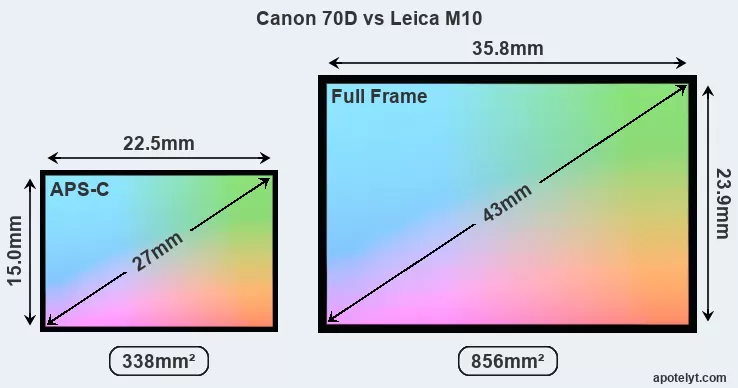
With 23.8MP, the M10 offers a higher resolution than the 70D (20MP), but the M10 nevertheless has larger individual pixels (pixel pitch of 6.00μm versus 4.11μm for the 70D) due to its larger sensor. Moreover, the M10 is a much more recent model (by 3 years and 6 months) than the 70D, and its sensor will have benefitted from technological advances during this time that further enhance the light gathering capacity of its pixel-units. Coming back to sensor resolution, it should be mentioned that the M10 has no anti-alias filter installed, so that it can capture all the detail its sensor resolves.
The resolution advantage of the Leica M10 implies greater flexibility for cropping images or the possibility to print larger pictures. The maximum print size of the M10 for good quality output (200 dots per inch) amounts to 29.8 x 20 inches or 75.6 x 50.7 cm, for very good quality (250 dpi) 23.8 x 16 inches or 60.5 x 40.6 cm, and for excellent quality (300 dpi) 19.8 x 13.3 inches or 50.4 x 33.8 cm. The corresponding values for the Canon 70D are 27.4 x 18.2 inches or 69.5 x 46.3 cm for good quality, 21.9 x 14.6 inches or 55.6 x 37.1 cm for very good quality, and 18.2 x 12.2 inches or 46.3 x 30.9 cm for excellent quality prints.
The 70D has on-sensor phase detect pixels, which results in fast and reliable autofocus acquisition even during live view operation.
The Canon EOS 70D has a native sensitivity range from ISO 100 to ISO 12800, which can be extended to ISO 100-25600. The corresponding ISO settings for the Leica M10 (Typ 3656) are ISO 100 to ISO 50000 (no boost).
Technology-wise, both cameras are equipped with CMOS (Complementary Metal–Oxide–Semiconductor) sensors. Both cameras use a Bayer filter for capturing RGB colors on a square grid of photosensors. This arrangement is found in most digital cameras.
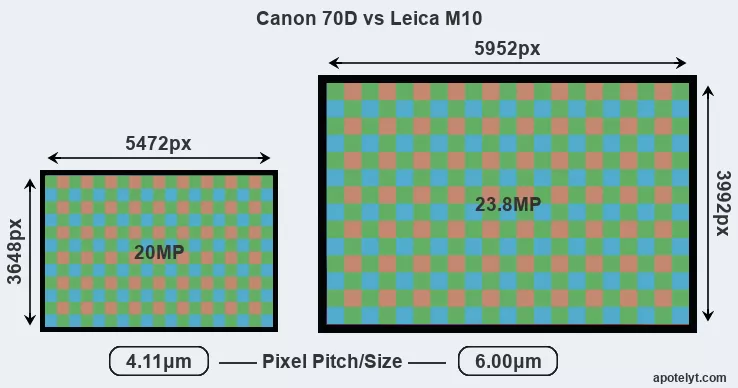
Consistent information on actual sensor performance is available from DXO Mark for many cameras. This service determines an overall sensor rating, as well as sub-scores for low-light sensitivity ("DXO Sports"), dynamic range ("DXO Landscape"), and color depth ("DXO Portrait"). Of the two cameras under consideration, the M10 offers substantially better image quality than the 70D (overall score 18 points higher). The advantage is based on 1.9 bits higher color depth, 1.6 EV in additional dynamic range, and 1.2 stops in additional low light sensitivity. The table below summarizes the physical sensor characteristics and sensor quality findings and compares them across a set of similar cameras.

| Camera Model |
Sensor Class |
Resolution (MP) |
Horiz. Pixels |
Vert. Pixels |
Video Format |
DXO Portrait |
DXO Landscape |
DXO Sports |
DXO Overall |
||
|---|---|---|---|---|---|---|---|---|---|---|---|
| 1. | Canon 70D | APS-C | 20.0 | 5472 | 3648 | 1080/30p | 22.5 | 11.6 | 926 | 68 | |
| 2. | Leica M10 | Full Frame | 23.8 | 5952 | 3992 | none | 24.4 | 13.2 | 2133 | 86 | |
| 3. | Canon 6D | Full Frame | 20.0 | 5472 | 3648 | 1080/30p | 23.8 | 12.1 | 2340 | 82 | |
| 4. | Canon 7D | APS-C | 17.9 | 5184 | 3456 | 1080/30p | 22.0 | 11.7 | 854 | 66 | |
| 5. | Canon 7D II | APS-C | 20.0 | 5472 | 3648 | 1080/60p | 22.4 | 11.8 | 1082 | 70 | |
| 6. | Canon 50D | APS-C | 15.1 | 4752 | 3168 | none | 21.8 | 11.4 | 696 | 63 | |
| 7. | Canon 60D | APS-C | 17.9 | 5184 | 3456 | 1080/30p | 22.2 | 11.5 | 813 | 66 | |
| 8. | Canon 80D | APS-C | 24.0 | 6000 | 4000 | 1080/60p | 23.6 | 13.2 | 1135 | 79 | |
| 9. | Canon G3 X | 1-inch | 20.0 | 5472 | 3648 | 1080/60p | 21.4 | 12.3 | 521 | 63 | |
| 10. | Canon T5 | APS-C | 17.9 | 5184 | 3456 | 1080/30p | 21.9 | 11.3 | 724 | 63 | |
| 11. | Leica M Typ 240 | Full Frame | 23.7 | 5952 | 3976 | 1080/25p | 24.0 | 13.3 | 1860 | 84 | |
| 12. | Leica M-E Typ 240 | Full Frame | 23.7 | 5952 | 3976 | 1080/25p | 25.2 | 14.2 | 2821 | 94 | |
| 13. | Leica M Typ 262 | Full Frame | 23.7 | 5952 | 3976 | none | 24.8 | 13.7 | 2478 | 90 | |
| 14. | Leica M10-P | Full Frame | 23.8 | 5952 | 3992 | none | 25.1 | 14.1 | 2739 | 93 | |
| 15. | Leica M11 | Full Frame | 60.3 | 9528 | 6328 | none | 26.3 | 14.8 | 3376 | 100 | |
| 16. | Nikon D7100 | APS-C | 24.0 | 6000 | 4000 | 1080/60p | 24.2 | 13.7 | 1256 | 83 | |
| 17. | Sony RX10 | 1-inch | 20.0 | 5472 | 3648 | 1080/60p | 22.9 | 12.6 | 474 | 69 | |
| Note: DXO values in italics represent estimates based on sensor size and age. | |||||||||||
Many modern cameras cannot only take still pictures, but also record videos. The 70D indeed provides movie recording capabilities, while the M10 does not. The highest resolution format that the 70D can use is 1080/30p.
Feature comparison
Beyond body and sensor, cameras can and do differ across a range of features. The 70D and the M10 are similar in the sense that both have an optical viewfinder. The latter is useful for getting a clear image for framing even in brightly lit environments. The viewfinder in the M10 offers a wider field of view (100%) than the one in the 70D (98%), so that a larger proportion of the captured image is visible in the finder. In addition, the viewfinder of the M10 has a higher magnification (0.73x vs 0.59x), so that the size of the image transmitted appears closer to the size seen with the naked human eye. The table below summarizes some of the other core capabilities of the Canon 70D and Leica M10 in connection with corresponding information for a sample of similar cameras.

| Camera Model |
Viewfinder (Type or 000 dots) |
Control Panel (yes/no) |
LCD Specifications (inch/000 dots) |
LCD Attach- ment |
Touch Screen (yes/no) |
Max Shutter Speed * |
Max Shutter Flaps * |
Built-in Flash (yes/no) |
Built-in Image Stab |
||
|---|---|---|---|---|---|---|---|---|---|---|---|
| 1. | Canon 70D | optical | Y | 3.0 / 1040 | swivel | Y | 1/8000s | 7.0/s | Y | n | |
| 2. | Leica M10 | optical | n | 3.0 / 1037 | fixed | n | 1/4000s | 5.0/s | n | n | |
| 3. | Canon 6D | optical | Y | 3.0 / 1040 | fixed | n | 1/4000s | 4.5/s | n | n | |
| 4. | Canon 7D | optical | Y | 3.0 / 920 | fixed | n | 1/8000s | 8.0/s | Y | n | |
| 5. | Canon 7D II | optical | Y | 3.0 / 1040 | fixed | n | 1/8000s | 10.0/s | Y | n | |
| 6. | Canon 50D | optical | Y | 3.0 / 920 | fixed | n | 1/8000s | 6.3/s | Y | n | |
| 7. | Canon 60D | optical | Y | 3.0 / 1040 | swivel | n | 1/8000s | 5.3/s | Y | n | |
| 8. | Canon 80D | optical | Y | 3.0 / 1040 | swivel | Y | 1/8000s | 7.0/s | Y | n | |
| 9. | Canon G3 X | optional | n | 3.2 / 1620 | tilting | Y | 1/2000s | 5.9/s | Y | Y | |
| 10. | Canon T5 | optical | n | 3.0 / 460 | fixed | n | 1/4000s | 3.0/s | Y | n | |
| 11. | Leica M Typ 240 | optical | n | 3.0 / 920 | fixed | n | 1/4000s | 3.0/s | n | n | |
| 12. | Leica M-E Typ 240 | optical | n | 3.0 / 920 | fixed | n | 1/4000s | 3.0/s | n | n | |
| 13. | Leica M Typ 262 | optical | n | 3.0 / 921 | fixed | n | 1/4000s | 3.0/s | n | n | |
| 14. | Leica M10-P | optical | n | 3.0 / 1037 | fixed | Y | 1/4000s | 5.0/s | n | n | |
| 15. | Leica M11 | optical | n | 3.0 / 2333 | fixed | Y | 1/4000s | 4.5/s | n | n | |
| 16. | Nikon D7100 | optical | Y | 3.2 / 1229 | fixed | n | 1/8000s | 6.0/s | Y | n | |
| 17. | Sony RX10 | 1440 | Y | 3.0 / 1229 | tilting | n | 1/3200s | 10.0/s | Y | Y | |
| Note: *) Information refers to the mechanical shutter, unless the camera only has an electronic one. | |||||||||||
One difference between the cameras concerns the presence of an on-board flash. The 70D has one, while the M10 does not. While the built-in flash of the 70D is not very powerful, it can at times be useful as a fill-in light.
The 70D has an articulated LCD that can be turned to be front-facing. This characteristic will be appreciated by vloggers and photographers who are interested in snapping selfies. In contrast, the M10 does not have a selfie-screen.The Leica M10 has an intervalometer built-in. This enables the photographer to capture time lapse sequences, such as flower blooming, a sunset or moon rise, without purchasing an external camera trigger and related software.
Concerning the storage of imaging data, both the 70D and the M10 write their files to SDXC cards. Both cameras can use UHS-I cards, which provide for Ultra High Speed data transfer of up to 104 MB/s.
Connectivity comparison
For some imaging applications, the extent to which a camera can communicate with its environment can be an important aspect in the camera decision process. The table below provides an overview of the connectivity of the Canon EOS 70D and Leica M10 (Typ 3656) and, in particular, the interfaces the cameras (and selected comparators) provide for accessory control and data transfer.

| Camera Model |
Hotshoe Port |
Internal Mic / Speaker |
Microphone Port |
Headphone Port |
HDMI Port |
USB Port |
WiFi Support |
NFC Support |
Bluetooth Support |
||
|---|---|---|---|---|---|---|---|---|---|---|---|
| 1. | Canon 70D | Y | stereo / mono | Y | - | mini | 2.0 | Y | - | - | |
| 2. | Leica M10 | Y | - / - | - | - | - | - | Y | - | - | |
| 3. | Canon 6D | Y | mono / mono | Y | - | mini | 2.0 | Y | - | - | |
| 4. | Canon 7D | Y | mono / - | Y | - | mini | 2.0 | - | - | - | |
| 5. | Canon 7D II | Y | stereo / mono | Y | Y | mini | 3.0 | - | - | - | |
| 6. | Canon 50D | Y | - / - | - | - | mini | 2.0 | - | - | - | |
| 7. | Canon 60D | Y | mono / mono | Y | - | mini | 2.0 | - | - | - | |
| 8. | Canon 80D | Y | stereo / mono | Y | Y | mini | 2.0 | Y | Y | - | |
| 9. | Canon G3 X | Y | stereo / mono | Y | Y | mini | 2.0 | Y | Y | - | |
| 10. | Canon T5 | Y | mono / mono | - | - | mini | 2.0 | - | - | - | |
| 11. | Leica M Typ 240 | Y | stereo / mono | - | - | - | 2.0 | - | - | - | |
| 12. | Leica M-E Typ 240 | Y | mono / - | - | - | - | 2.0 | - | - | - | |
| 13. | Leica M Typ 262 | Y | - / - | - | - | - | 2.0 | - | - | - | |
| 14. | Leica M10-P | Y | - / - | - | - | - | - | Y | - | - | |
| 15. | Leica M11 | Y | - / - | - | - | - | 3.2 | Y | - | Y | |
| 16. | Nikon D7100 | Y | stereo / mono | Y | Y | mini | 2.0 | - | - | - | |
| 17. | Sony RX10 | Y | stereo / mono | Y | Y | micro | 2.0 | Y | Y | - |
Both the 70D and the M10 have been discontinued, but can regularly be found used on ebay. The 70D was replaced by the Canon 80D, while the M10 was followed by the Leica M11. Further information on the features and operation of the 70D and M10 can be found, respectively, in the Canon 70D Manual (free pdf) or the online Leica M10 Manual.
Review summary
So how do things add up? Is the Canon 70D better than the Leica M10 or vice versa? Below is a summary of the relative strengths of each of the two contestants.

Reasons to prefer the Canon EOS 70D:
- Better moiré control: Has an anti-alias filter to avoid artificial patterns to appear in images.
- Broader imaging potential: Can record not only still images but also 1080/30p movies.
- Better live-view autofocus: Features on-sensor phase-detection for more confident autofocus.
- Easier setting verification: Features an LCD display on top to control shooting parameters.
- More flexible LCD: Has a swivel screen for odd-angle shots in portrait or landscape orientation.
- Fewer buttons to press: Is equipped with a touch-sensitive rear screen to facilitate handling.
- More selfie-friendly: Has an articulated screen that can be turned to be front-facing.
- Faster shutter: Has higher mechanical shutter speed (1/8000s vs 1/4000s) to freeze action.
- Faster burst: Shoots at higher frequency (7 vs 5 flaps/sec) to capture the decisive moment.
- Longer lasting: Can take more shots (920 versus 210) on a single battery charge.
- Easier fill-in: Is equipped with a small onboard flash to brighten deep shadow areas.
- More affordable: Was introduced into a lower priced category (82 percent cheaper at launch).
- More heavily discounted: Has been available for much longer (launched in July 2013).

Advantages of the Leica M10 (Typ 3656):
- More detail: Has more megapixels (23.8 vs 20MP), which boosts linear resolution by 9%.
- Maximized detail: Lacks an anti-alias filter to exploit the sensor's full resolution potential.
- Better image quality: Scores substantially higher (18 points) in the DXO overall evaluation.
- Richer colors: Generates noticeably more natural colors (1.9 bits more color depth).
- More dynamic range: Captures a broader range of light and dark details (1.6 EV of extra DR).
- Better low-light sensitivity: Can shoot in dim conditions (1.2 stops ISO advantage).
- More complete view: Has a viewfinder with a larger field of view (100% vs 98%).
- Larger viewfinder image: Features a viewfinder with a higher magnification (0.73x vs 0.59x).
- Easier time-lapse photography: Has an intervalometer built-in for low frequency shooting.
- More compact: Is smaller (139x80mm vs 139x104mm) and will fit more readily into a bag.
- Less heavy: Has a lower weight (by 95g or 13 percent) and is thus easier to take along.
- More prestigious: Has the Leica luxury appeal, which ensures a high resale value.
- More modern: Reflects 3 years and 6 months of technical progress since the 70D launch.
If the count of individual advantages (bullet points above) is taken as a guide, the match-up finishes in a tie (13 points each). However, the relevance of individual strengths will vary across photographers, so that you might want to apply your own weighing scheme to the summary points when reflecting and deciding on a new camera. A professional sports photographer will view the differences between cameras in a way that diverges from the perspective of a street photog, and a person interested in family portraits has distinct needs from a landscape shooter. Hence, the decision which camera is best and worth buying is often a very personal one.
In any case, while the comparison of technical specifications can provide a useful overview of the capabilities of different cameras, it remains incomplete and does no justice, for example, to the way the 70D or the M10 perform in practice. User reviews, such as those found at amazon, can sometimes inform about these issues, but such feedback is often incomplete, inconsistent, and biased.
Expert reviews
This is why expert reviews are important. The table below provides a synthesis of the camera assessments of some of the best known photo-gear review sites (amateurphotographer [AP], cameralabs [CL], digitalcameraworld [DCW], dpreview [DPR], ephotozine [EPZ], photographyblog [PB]). As can be seen, the professional reviewers agree in many cases on the quality of different cameras, but sometimes their assessments diverge, reinforcing the earlier point that a camera decision is often a very personal choice.

| Camera Model |
AP score |
CL score |
DCW score |
DPR score |
EPZ score |
PB score |
Camera Launch |
Launch Price (USD) |
Street Price |
||
|---|---|---|---|---|---|---|---|---|---|---|---|
| 1. | Canon 70D | 5/5 | + + | .. | 83/100 | 4.5/5 | 5/5 | Jul 2013 | 1,199 | ebay.com | |
| 2. | Leica M10 | 4.5/5 | .. | .. | .. | 4/5 | 4.5/5 | Jan 2017 | 6,595 | ebay.com | |
| 3. | Canon 6D | 5/5 | + + | .. | 83/100 | 4.5/5 | 4.5/5 | Sep 2012 | 2,099 | ebay.com | |
| 4. | Canon 7D | 5/5 | + + | .. | 84/100 | 4.5/5 | 4.5/5 | Sep 2009 | 1,699 | ebay.com | |
| 5. | Canon 7D II | 4.5/5 | + | 3.5/5 | 84/100 | 4/5 | 4.5/5 | Sep 2014 | 1,799 | ebay.com | |
| 6. | Canon 50D | .. | + + | .. | + + | 4.5/5 | 4.5/5 | Aug 2008 | 1,299 | ebay.com | |
| 7. | Canon 60D | 5/5 | + | .. | 79/100 | 4/5 | 4.5/5 | Aug 2010 | 1,399 | ebay.com | |
| 8. | Canon 80D | 4/5 | + + | 4.5/5 | 84/100 | 4.5/5 | 4.5/5 | Feb 2016 | 1,199 | ebay.com | |
| 9. | Canon G3 X | 3.5/5 | + | .. | .. | 4.5/5 | 4/5 | Jun 2015 | 999 | ebay.com | |
| 10. | Canon T5 | 3/5 | + | .. | .. | 4/5 | 4.5/5 | Feb 2014 | 449 | ebay.com | |
| 11. | Leica M Typ 240 | 4/5 | .. | .. | .. | 4/5 | .. | Sep 2012 | 6,950 | ebay.com | |
| 12. | Leica M-E Typ 240 | .. | .. | .. | .. | .. | .. | Jun 2019 | 3,999 | ebay.com | |
| 13. | Leica M Typ 262 | .. | .. | .. | .. | .. | .. | Nov 2015 | 5,195 | ebay.com | |
| 14. | Leica M10-P | .. | .. | 3/5 | .. | .. | 4/5 | Aug 2018 | 7,995 | ebay.com | |
| 15. | Leica M11 | 4.5/5 | .. | 4.5/5 | .. | 4.5/5 | 4.5/5 | Jan 2022 | 8,995 | amazon.com | |
| 16. | Nikon D7100 | 5/5 | + + | .. | 85/100 | 4.5/5 | 4.5/5 | Feb 2013 | 1,199 | ebay.com | |
| 17. | Sony RX10 | 5/5 | + | .. | 80/100 | 4.5/5 | 4.5/5 | Oct 2013 | 1,299 | ebay.com | |
| Note: (+ +) highly recommended; (+) recommended; (o) reviewed; (..) not available. | |||||||||||
The above review scores should be interpreted with care, though. The ratings are only valid when referring to cameras in the same category and of the same age. Hence, a score should always be seen in the context of the camera's market launch date and its price, and comparing ratings of very distinct cameras or ones that are far apart in terms of their release date have little meaning. Also, please note that some of the review sites have changed their methodology and reporting over time.

Check 70D offers at
ebay.com

Check M10 offers at
ebay.com
Other camera comparisons
Did this review help to inform your camera decision process? If you would like to see a different side-by-side camera review, just make a corresponding selection in the search boxes below. Alternatively, you can follow any of the listed hyperlinks for comparisons that others found interesting.
Specifications: Canon 70D vs Leica M10
Below is a side-by-side comparison of the specs of the two cameras to facilitate a quick review of their differences and common features.
| Camera Model | Canon 70D | Leica M10 |
|---|---|---|
| Camera Type | Digital single lens reflex | Rangefinder camera |
| Camera Lens | Canon EF mount lenses | Leica M mount lenses |
| Launch Date | July 2013 | January 2017 |
| Launch Price | USD 1,199 | USD 6,595 |
| Sensor Specs | Canon 70D | Leica M10 |
| Sensor Technology | CMOS | CMOS |
| Sensor Format | APS-C Sensor | Full Frame Sensor |
| Sensor Size | 22.5 x 15.0 mm | 35.8 x 23.9 mm |
| Sensor Area | 337.5 mm2 | 855.62 mm2 |
| Sensor Diagonal | 27 mm | 43 mm |
| Crop Factor | 1.6x | 1.0x |
| Sensor Resolution | 20 Megapixels | 23.8 Megapixels |
| Image Resolution | 5472 x 3648 pixels | 5952 x 3992 pixels |
| Pixel Pitch | 4.11 μm | 6.00 μm |
| Pixel Density | 5.91 MP/cm2 | 2.78 MP/cm2 |
| Moiré control | Anti-Alias filter | no AA filter |
| Movie Capability | 1080/30p Video | no Video |
| ISO Setting | 100 - 12,800 ISO | 100 - 50,000 ISO |
| ISO Boost | 100 - 25,600 ISO | no Enhancement |
| Image Processor | DIGIC 5+ | Maestro II |
| DXO Sensor Quality (score) | 68 | 86 |
| DXO Color Depth (bits) | 22.5 | 24.4 |
| DXO Dynamic Range (EV) | 11.6 | 13.2 |
| DXO Low Light (ISO) | 926 | 2133 |
| Screen Specs | Canon 70D | Leica M10 |
| Viewfinder Type | Optical viewfinder | Optical viewfinder |
| Viewfinder Field of View | 98% | 100% |
| Viewfinder Magnification | 0.59x | 0.73x |
| Top-Level Screen | Control Panel | no Top Display |
| LCD Framing | Live View | Live View |
| Rear LCD Size | 3.0inch | 3.0inch |
| LCD Resolution | 1040k dots | 1037k dots |
| LCD Attachment | Swivel screen | Fixed screen |
| Touch Input | Touchscreen | no Touchscreen |
| Shooting Specs | Canon 70D | Leica M10 |
| Focus System | Phase-detect AF | Manual Focus |
| Manual Focusing Aid | no Peaking Feature | Focus Peaking |
| Max Shutter Speed (mechanical) | 1/8000s | 1/4000s |
| Continuous Shooting | 7 shutter flaps/s | 5 shutter flaps/s |
| Time-Lapse Photography | no Intervalometer | Intervalometer built-in |
| Fill Flash | Built-in Flash | no On-Board Flash |
| Storage Medium | SDXC cards | SDXC cards |
| Single or Dual Card Slots | Single card slot | Single card slot |
| UHS card support | UHS-I | UHS-I |
| Connectivity Specs | Canon 70D | Leica M10 |
| External Flash | Hotshoe | Hotshoe |
| USB Connector | USB 2.0 | no USB |
| HDMI Port | mini HDMI | no HDMI |
| Microphone Port | External MIC port | no MIC socket |
| Wifi Support | Wifi built-in | Wifi built-in |
| Body Specs | Canon 70D | Leica M10 |
| Environmental Sealing | Weathersealed body | Weathersealed body |
| Battery Type | Canon LP-E6 | Leica BP-SCL5 |
| Battery Life (CIPA) | 920 shots per charge | 210 shots per charge |
| Body Dimensions |
139 x 104 x 79 mm (5.5 x 4.1 x 3.1 in) |
139 x 80 x 39 mm (5.5 x 3.1 x 1.5 in) |
| Camera Weight | 755 g (26.6 oz) | 660 g (23.3 oz) |

Check 70D offers at
ebay.com

Check M10 offers at
ebay.com
Did you notice an error on this page? If so, please get in touch, so that we can correct the information.
